Introduction: Addressing One of Agriculture’s Biggest Challenges
Labor costs continue to rise across the agriculture industry, driven by seasonal shortages, increased wages, and competition for skilled workers. For many growers, this makes labor one of the most significant and unpredictable expenses.
Autonomous farming solutions provide a practical way to reduce labor costs without compromising productivity. By automating repetitive, time-intensive tasks, these systems help growers reallocate human resources to higher-value work while improving operational consistency.
The Impact of Labor Costs on Farming Operations
For most growers, labor represents a major portion of total operating expenses. High turnover, training requirements, and the need to find additional workers during peak seasons create both financial and operational strain.
Reducing dependency on manual labor for repetitive fieldwork is one of the most effective ways to control costs and stabilize workflows.
How Autonomous Solutions Reduce Labor Costs
1. Automating Repetitive Tasks
Autonomous systems can take over labor-heavy tasks such as spraying and chemical spreading. This reduces the number of hours needed from seasonal crews and allows existing staff to focus on more skilled work.
2. Maximizing One Operator’s Productivity
A single operator can manage multiple autonomous machines from the cab of a support vehicle or from an office using a fleet management platform like Bluewhite Compass.
3. Extending Operating Hours
Autonomous machines can work during nights, weekends, and in conditions where manual labor is limited, increasing operational coverage without adding labor shifts.
4. Reducing Overtime and Seasonal Hiring
By running autonomous operations in parallel with manual tasks, growers can eliminate or significantly reduce costly overtime and the need to expand crews during peak demand.
Bluewhite’s Approach to Labor Efficiency
Bluewhite delivers autonomy in a way that is accessible and cost-effective for growers of all sizes.
Pathfinder Retrofit Kit
Converts existing tractors into autonomous machines, eliminating the need to invest in entirely new fleets.
GEN 4 Autonomous System
Integrates advanced AI, LiDAR, and camera perception for precise navigation and task execution.
Compass Fleet Management Platform
Centralizes oversight, allowing one operator to manage multiple machines with real-time visibility and control.
Practical Example: Labor Reduction in Action
A permanent crop grower using Bluewhite’s autonomous spraying setup was able to reduce the number of seasonal spray operators from three to one. This shift freed the remaining labor for other critical tasks during the busy spring season, while maintaining consistent spray quality.
Additional Benefits Beyond Labor Savings
While labor cost reduction is the primary focus, autonomous farming systems also deliver:
- Chemical Optimization: Reducing overspray and waste lowers input costs.
- Sustainability: Lower fuel consumption and precise application support environmental stewardship.
- Safety: Minimizing human exposure to chemicals and challenging field conditions.
FAQs: Reducing Labor Costs with Autonomy
Q: Will autonomy replace my entire crew?
Not necessarily. Autonomy reduces the need for repetitive labor, allowing your team to focus on other essential tasks.
Q: Can I use my existing tractors?
Yes. Bluewhite’s Pathfinder kit is designed to retrofit most existing tractors and implements.
Q: Is it complicated to manage multiple autonomous machines?
No. With Compass, one operator can monitor and control multiple machines from a single dashboard.
Conclusion: A Smarter Way to Manage Labor Costs
Autonomous farming solutions offer growers a proven way to reduce labor costs while increasing efficiency and operational flexibility. By integrating retrofit technology, advanced navigation, and centralized management, Bluewhite helps farms of all sizes maintain high productivity with fewer labor expenses.

